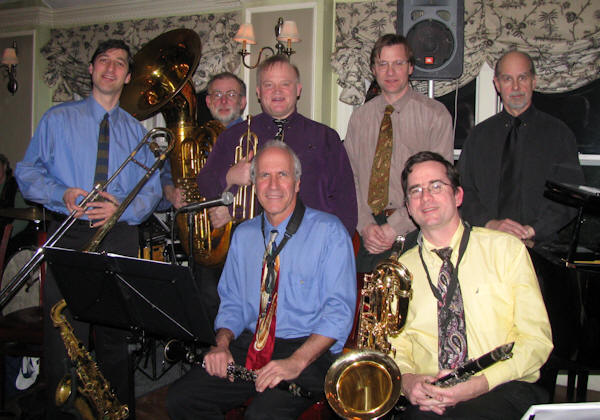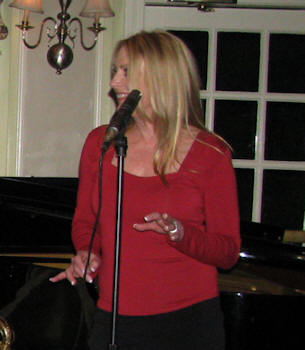Billy Novick's Blue Syncopators
Preview "The Great Gatsby" at the Sherborn Inn
by Marce
 |
|
Heads up, Shirley Friedman and folks
from the Potomac River Jazz Society! You're in for a treat!
Get ready to go to the ballet - but this isn't your Grandmother's
Ballet.
Preview: We were privileged
Tuesday, February 4th, at the Sherborn Inn to get a glimpse of F. Scott Fitzgerald's The Great Gatsby that will be
brought to life by Septime Webre and the artists of the Washington
Ballet on
February 24-28 at the Eisenhower Theater, John F. Kennedy Center for the Performing Arts
in Washington D.C. Music composed by Billy Novick.
Billy Novick acted as
narrator, telling the story, sans ballet dancers, and playing the hot,
passionate Traditional and Dixieland Jazz that was the rage in the
'Gatsby' era of the 1920's. Billy Novick on clarinet and alto sax,
John Clark-clarinet, tenor and bari sax, Mike Peipman-trumpet,
Dan
Fox-trombone, Ross Petot-piano, Stu Gunn-acoustic string bass and tuba,
and Bill Reynolds-drums.
Billy ingeniously blended his own
compositions with some of our favorite early Jazz tunes and came up with an
extraordinary presentation, with the help of beautiful and talented Sunny Crownover, (she's
not coming to DC - busy making a CD with Duke Robillard.)
The ballet begins with
What'll I Do, a silky, melodic waltz, with Billy on sweet, low
register clarinet, John Clark harmonizing on bari sax, and Ross making
that piano sing, as the story enfolds and the rich and influential
Gatsby falls in love with the very rich, the very elegant, and the very
married Daisy
|
An outstanding vocalist with a wide range,
Sunny
gave a flawless impression of Adelaide Hall's Creole Love Call, and as a red hot Mama with St. Louis Blues,
backed by Mike Peipman's searing trumpet.
Sunny and Billy's poignant scatting
on Wild Man Blues characterized a touching, emotional telephone conversation between
the two
lovers. |
 |
In Billy's composition, Cityscape,
the instruments cunningly reproduce the haphazard cacophony of a busy
New York thoroughfare; while in a tennis match scene,
Billy's drumming replicates the sound of tennis balls being batted back
and forth. Brilliant. A scene where a couple are
dining at the Waldorf was portrayed by Broadway
Tango. Then to fill in a
gap in the action where 20 ballet dancers need to change from white into red tap shoes,
Billy wrote Maid to Order. It takes a while for 20 dancers to change into new shoes!
Yellow Dog Blues and the
Charleston recalled some wild parties that were held in Myrtle's
apartment and Gatsby's mansion.
Billy did the vocal on Tight Like That, which he will NOT be doing in
DC! He needed a wartime tune for a scene where somebody goes into
the army, but had difficulty finding an American
World War I march.
Diligent probing paid off when he discovered a tune from an old vintage phonograph, We're All Going
Calling on the Kaiser. (We're going to make him wiser.)
Bill Reynolds had the final scene, with
George stalking Gatsby, his
anger building with the drumming, as he finds him swimming in the pool, and
then the
final single drum beat - the gun shot. The epilogue returns
to the heartrending waltz, with Billy on clarinet and Ross piano, with a
plaintive What'll I
Do.
Billy managed to fit in many of the
old tunes that are very familiar to us, Old Blues, Jazz Me Blues,
Swipsey Cakewalk, East St. Louis Too da Loo, I'll See You In My Dreams,
Happy Feet. Most of these will be 'new' to the audience in DC.
Maybe, just maybe, this new old jazz will catch on!
Shirley and the other PRJS folk, you most fortunate Jazz Fans, get to see the REAL thing, complete with Septime Webre and the
artists of the Washington Ballet. But get
your tickets quickly, because most of the prime and side orchestra seats
are already sold out!
Tickets
$25-$125.
Performance Dates and Times::
Wednesday, February 24 at 8 PM (preview)
Thursday, February 25 at 8 PM (opening)
Friday, February 26 at 8 PM
Saturday, February 27 at 2:30 PM and 8 PM
Sunday, February 28 at 1 PM and 5:30 PM
Also: Making the Great Gatsby
February 8th - Get a rare opportunity to see a great dance work
come together. Artistic Director Septime Webre and Artistic Associate
David Palmer lead this hour-long fascinating dialogue on how to dissect
a story and build a ballet.
See the Music, Hear the Dance April 6th - An engaging, hour-long
lecture/demonstration for dance and music lovers alike, this
inthewings focuses on the intrinsic connection between the two art
forms. Dancers and choreographers will illustrate the importance of
being able to “see the music and hear the dance.” (George Balanchine)
|
BACK TO TOP
|
| By Marce,
February 5, 2010 |
|